A couple of weeks ago we began leading you through the complex array of horse bit types. We covered the variety of mouthpieces most commonly used, but cheek pieces also play a crucial role in how a bit functions. As a reminder, all horse bit types are built of two main components: the mouthpiece and the cheek pieces.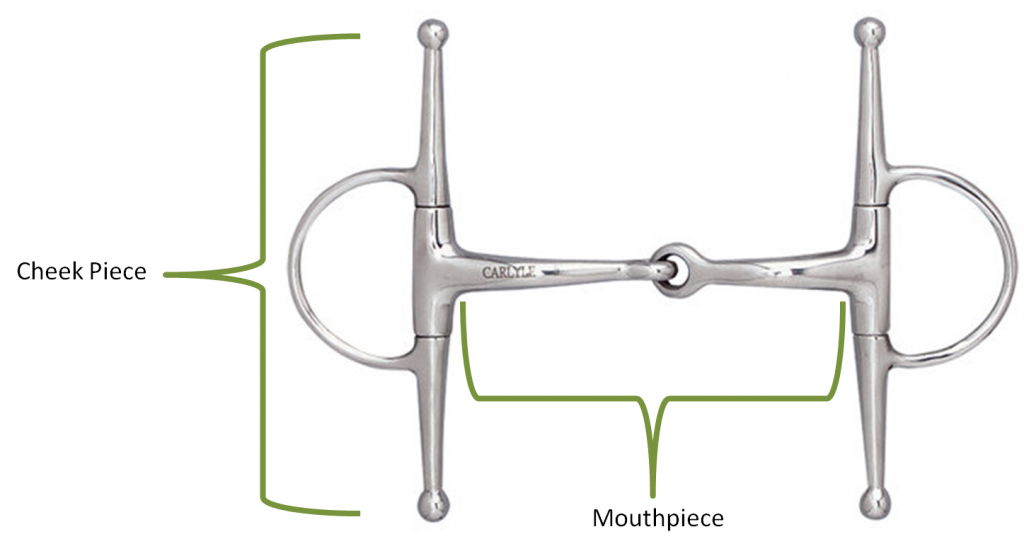
Cheek pieces are use to categorize horse bit types, which generally fall into two main categories: snaffles and curbs. A snaffle bit is a non-leverage bit with the rein attaching directly to the mouthpiece, while a curb bit provides leverage with the rein attached to a shank. The Pelham is a type of bit that is an exception as it falls into both these categories and is used with two sets of reins.
As with mouthpieces, the cheek pieces you select will depend on the same factors, which include rider experience, horse temperament and level of training, discipline and training goals. Each combination of cheek pieces and mouthpiece will have a different effect, so make sure to work with your trainer to decide which bits will be most helpful with your specific horse and goals. To help guide you, here are the most common cheek pieces you will find:
- Loose Ring – Round, ring shaped and
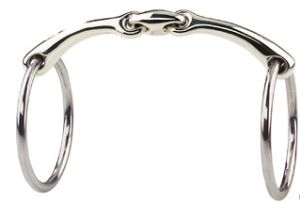 allowed to move laterally through holes in the mouthpiece. Helps the mouthpiece lie naturally in the horse’s mouth and move separately with their mouth movements when the rider’s hands are maintaining rein pressure. Can help provide sensitive contact while discouraging the horse from leaning on the bit. Should be sized up slightly to ensure the horse’s lips are not pinched in the moving rings; rubber bit guards can also help prevent pinching with a loose ring, although their use is not permitted in all disciplines. An example is the Herm Sprenger Dynamic RS Sensogan® Loose Ring.
allowed to move laterally through holes in the mouthpiece. Helps the mouthpiece lie naturally in the horse’s mouth and move separately with their mouth movements when the rider’s hands are maintaining rein pressure. Can help provide sensitive contact while discouraging the horse from leaning on the bit. Should be sized up slightly to ensure the horse’s lips are not pinched in the moving rings; rubber bit guards can also help prevent pinching with a loose ring, although their use is not permitted in all disciplines. An example is the Herm Sprenger Dynamic RS Sensogan® Loose Ring. 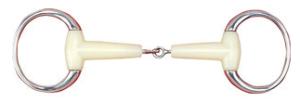 Eggbutt – Rounded ring attached in a fixed manner with thicker, flared areas near the attachment point. Swivel joints are just past where the horse’s lips would lay, minimizing pinching. Good choice for an all-purpose bit. An example is Happy Mouth Jointed Eggbutt Snaffle Bit.
Eggbutt – Rounded ring attached in a fixed manner with thicker, flared areas near the attachment point. Swivel joints are just past where the horse’s lips would lay, minimizing pinching. Good choice for an all-purpose bit. An example is Happy Mouth Jointed Eggbutt Snaffle Bit.- D-Ring – “D” shaped ring that is attached at a fixed point to the mouthpiece.
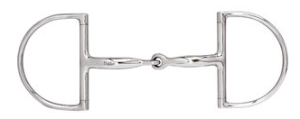 Because the swivel points are at the top and bottom of the flat side of the “D,” and the flat side is stationary, this bit provides a small amount of leverage depending on the angle at which the rider applies the rein aids. Will not slide through the horse’s mouth and provides additional control with turning, although not as much as a full cheek. An example is the Hunter Dee Ring Snaffle Bit.
Because the swivel points are at the top and bottom of the flat side of the “D,” and the flat side is stationary, this bit provides a small amount of leverage depending on the angle at which the rider applies the rein aids. Will not slide through the horse’s mouth and provides additional control with turning, although not as much as a full cheek. An example is the Hunter Dee Ring Snaffle Bit. 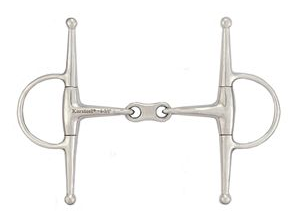 Full Cheek – Small, round or “D” shaped ring attached at a fixed point to the mouthpiece with an arm extending above and below the ring. Because the arms apply pressure laterally to the horse’s mouth when the opposite rein aid is used, this type of bit can be useful as a stronger turning aid. Will not pull through the horse’s mouth because of the arms. Bit keepers should be used to secure the bit in place and prevent the arms from interfering with the nostrils. An example is the JP Korsteel French Link Full Cheek Snaffle Bit.
Full Cheek – Small, round or “D” shaped ring attached at a fixed point to the mouthpiece with an arm extending above and below the ring. Because the arms apply pressure laterally to the horse’s mouth when the opposite rein aid is used, this type of bit can be useful as a stronger turning aid. Will not pull through the horse’s mouth because of the arms. Bit keepers should be used to secure the bit in place and prevent the arms from interfering with the nostrils. An example is the JP Korsteel French Link Full Cheek Snaffle Bit.- Weymouth & Bradoon – Used
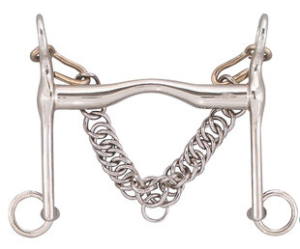 together in a double bridle with two sets of reins, the Weymouth is the curb bit and the bradoon is the snaffle bit. The top reins are attached to the bradoon, which should be sized slightly larger. The bottom, or curb, reins are attached to the Weymouth. The combination helps the rider to communicate precise rein aids to the horse with the bradoon, while the Weymouth applies poll
together in a double bridle with two sets of reins, the Weymouth is the curb bit and the bradoon is the snaffle bit. The top reins are attached to the bradoon, which should be sized slightly larger. The bottom, or curb, reins are attached to the Weymouth. The combination helps the rider to communicate precise rein aids to the horse with the bradoon, while the Weymouth applies poll  pressure for leverage. An example of a Weymouth is the Herm Sprenger HS Weymouth Bit, and an example of a bradoon is the Loose Ring Bradoon.
pressure for leverage. An example of a Weymouth is the Herm Sprenger HS Weymouth Bit, and an example of a bradoon is the Loose Ring Bradoon.  Pelham – This is the cheek piece with features that could categorize its bit into both snaffle and curb categories. Fixed ring with curb shanks, where a rein will attach to each. Intended to work as a double bridle would, while eliminating the need for two bits. Curb chains are used with these bits to put a limit to the amount of pressure that will be placed on the poll. A converter strap can be used to allow use of one rein. An example is the JP Korsteel Jointed Eggbutt Pelham Bit.
Pelham – This is the cheek piece with features that could categorize its bit into both snaffle and curb categories. Fixed ring with curb shanks, where a rein will attach to each. Intended to work as a double bridle would, while eliminating the need for two bits. Curb chains are used with these bits to put a limit to the amount of pressure that will be placed on the poll. A converter strap can be used to allow use of one rein. An example is the JP Korsteel Jointed Eggbutt Pelham Bit.- Elevator – A series of
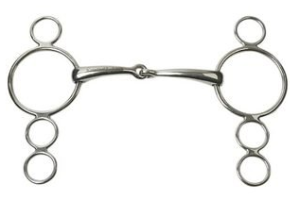 round rings vertically, with one ring in the snaffle position and others creating a shank. The cheek pieces of the bridle are attached to a small top ring above the snaffle ring, while reins can be attached to the snaffle ring or to a small ring below the snaffle ring. Some elevator bits have two smaller rings below the snaffle ring position. The lower the reins are placed, the greater the leverage and the more pressure placed on the poll. These bits can also be used with two reins, similarly to the Pelham. An example is the JP Three-Ring Elevator Bit.
round rings vertically, with one ring in the snaffle position and others creating a shank. The cheek pieces of the bridle are attached to a small top ring above the snaffle ring, while reins can be attached to the snaffle ring or to a small ring below the snaffle ring. Some elevator bits have two smaller rings below the snaffle ring position. The lower the reins are placed, the greater the leverage and the more pressure placed on the poll. These bits can also be used with two reins, similarly to the Pelham. An example is the JP Three-Ring Elevator Bit.  Gag – Round ring with a small hole in the top and bottom through which an over-cheek rein passes. The rein will continue up through the headstall and then to the rider’s hands. The leverage action of this bit works opposite many of the others discussed, lifting the horse’s head upwards. There is simultaneously poll pressure, aiding in keeping the horse’s head in a structured area. An example is the Herm Sprenger KK Ultra Gag Bit.
Gag – Round ring with a small hole in the top and bottom through which an over-cheek rein passes. The rein will continue up through the headstall and then to the rider’s hands. The leverage action of this bit works opposite many of the others discussed, lifting the horse’s head upwards. There is simultaneously poll pressure, aiding in keeping the horse’s head in a structured area. An example is the Herm Sprenger KK Ultra Gag Bit.- Kimberwicke – “D” shaped ring
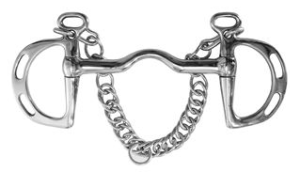 attached at a fixed point to the mouthpiece, with two openings for rein attachment on the curved portion of the “D” shape. A small oval above the ring is used for attachment to cheek piece of the bridle. The two rein openings allow for options on amount of leverage desired, with the lower opening providing more. Works similarly to a Pelham by including features of both snaffle and curb style bits. An example is the Uxeter Kimberwicke Bit.
attached at a fixed point to the mouthpiece, with two openings for rein attachment on the curved portion of the “D” shape. A small oval above the ring is used for attachment to cheek piece of the bridle. The two rein openings allow for options on amount of leverage desired, with the lower opening providing more. Works similarly to a Pelham by including features of both snaffle and curb style bits. An example is the Uxeter Kimberwicke Bit. 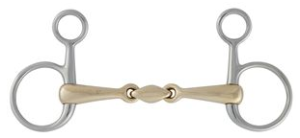 Baucher – A lowercase “b” shaped cheek piece; the rein is attached to a round snaffle ring, while an arm extends upwards to attach to the bridle’s cheek piece at a small round ring above. Applies pressure to the poll through a snaffle ring, as the upper rings and bridle cheek pieces are pulled forward and down when rein aids are used. An example is the Stubben Sweet Copper Baucher Bit.
Baucher – A lowercase “b” shaped cheek piece; the rein is attached to a round snaffle ring, while an arm extends upwards to attach to the bridle’s cheek piece at a small round ring above. Applies pressure to the poll through a snaffle ring, as the upper rings and bridle cheek pieces are pulled forward and down when rein aids are used. An example is the Stubben Sweet Copper Baucher Bit.
Each of these types of cheek pieces when combined with different mouthpieces will have slightly different effects, so make sure you consider all the aspects and how they will work with the specific needs of your horse. Talk with your trainer or other reputable professional as you navigate through the many horse bit types. Don’t forget- different bits may work more effectively for different sets of goals, so investing in a few can be a great idea! Additionally, as your horse’s training progresses you may find the qualities you want from a bit will change also. No matter what your needs, the right bits will help you reach your goal.

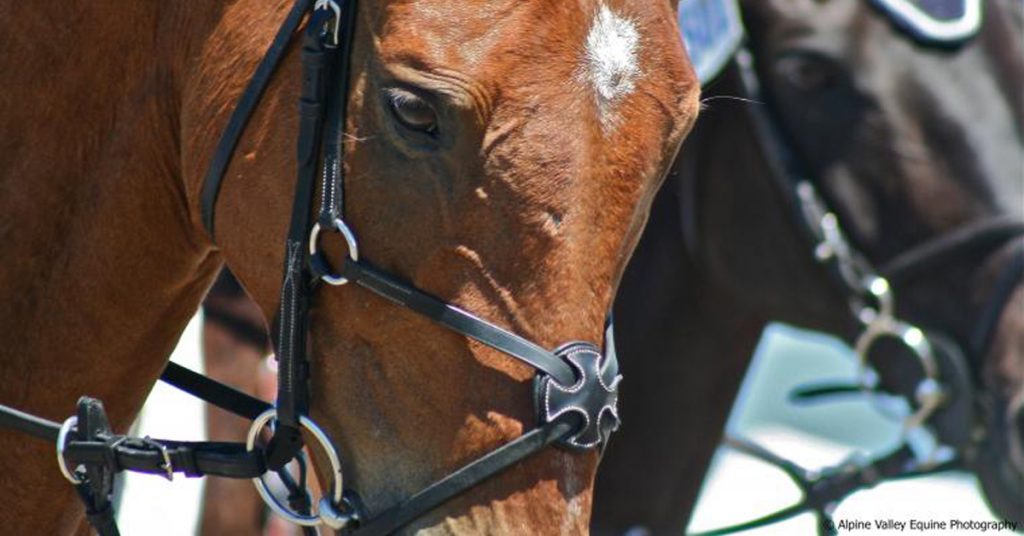
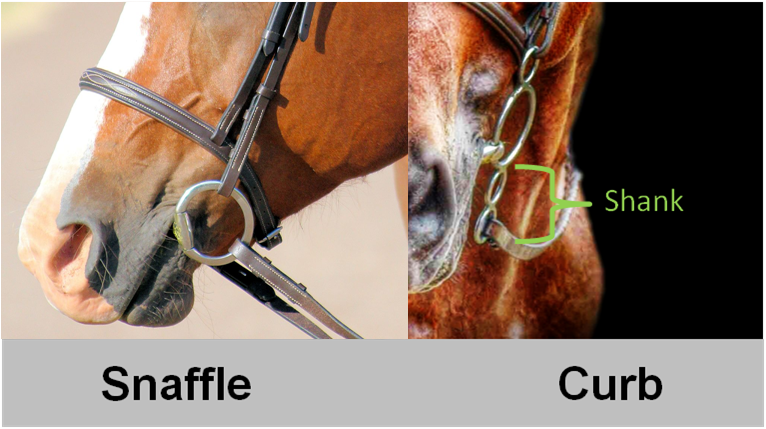
This is very informative and, I believe, a huge help to those trying to understand some of the different types of equestrian equipment. I hope you will continue this forum and extend it to all types of equine equipment available to the rider, e.g. saddles, pads, irons, bridles, etc.
Thank you!
We are so glad you found it helpful! Is there are particular type of tack you’d like a similar article on?
You’ve got some misinformation up there. The three ring gag is not an elevator bit. It’s a gag action curb bit. An elevator bit always has a 1:1 ratio, the purchase and shank are the same length. A gag bit has a purchase to shank ratio that inverts as the bit rotates. The 3 ring gag is an older version gag bit, actually first used in western events. I have one made by Winchester from the 70s, where the original name was Wonder bit ( the modern wonder bit is named after it) It was in use well before the jumper crowd discovered it. Gag bits are gag bits and elevator bits are elevator bits. Sometimes terminology is added to a bit, that is incorrect, simply because a celebrity rider misapplies the name. However, these incorrect names cause problems when newcomers go to order bits and find that what they thought was the correct bit is not. There are plenty of old catalogs, cavalry manuals, old rulebooks etc that have the correct terminology.
The three ring gag is featured in an ad in Western Horseman in the 60s. It is most assuredly not an elevator bit.